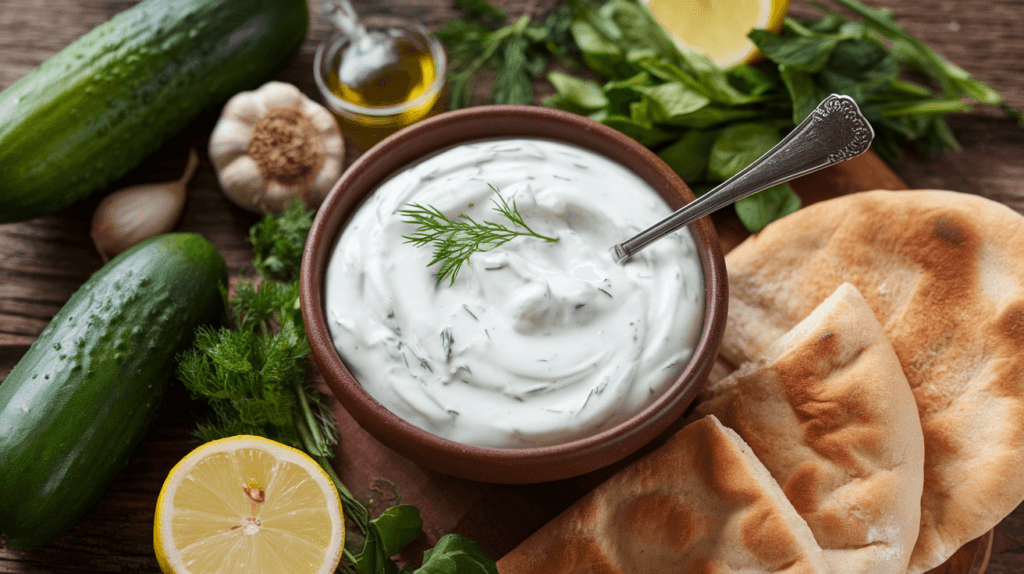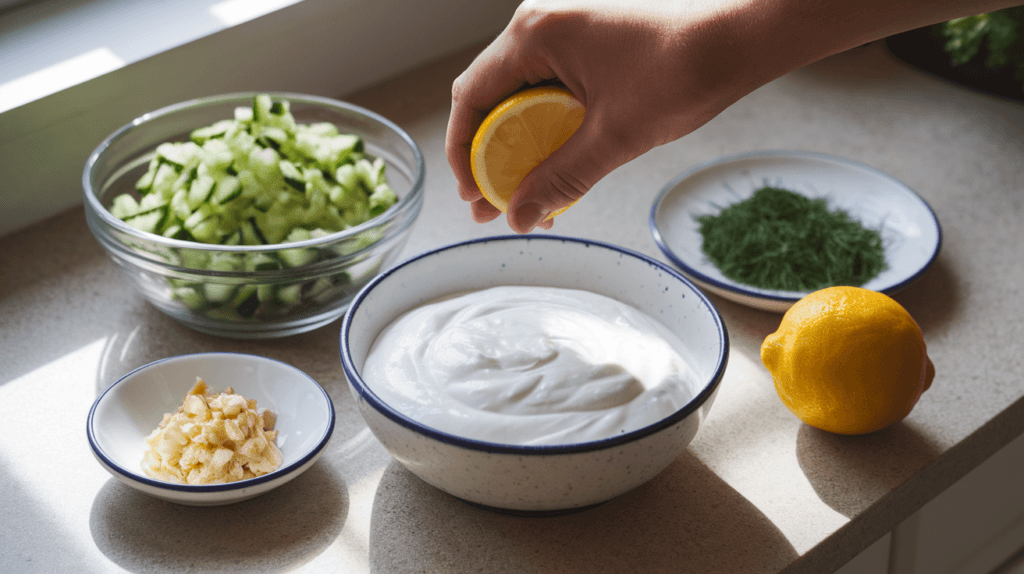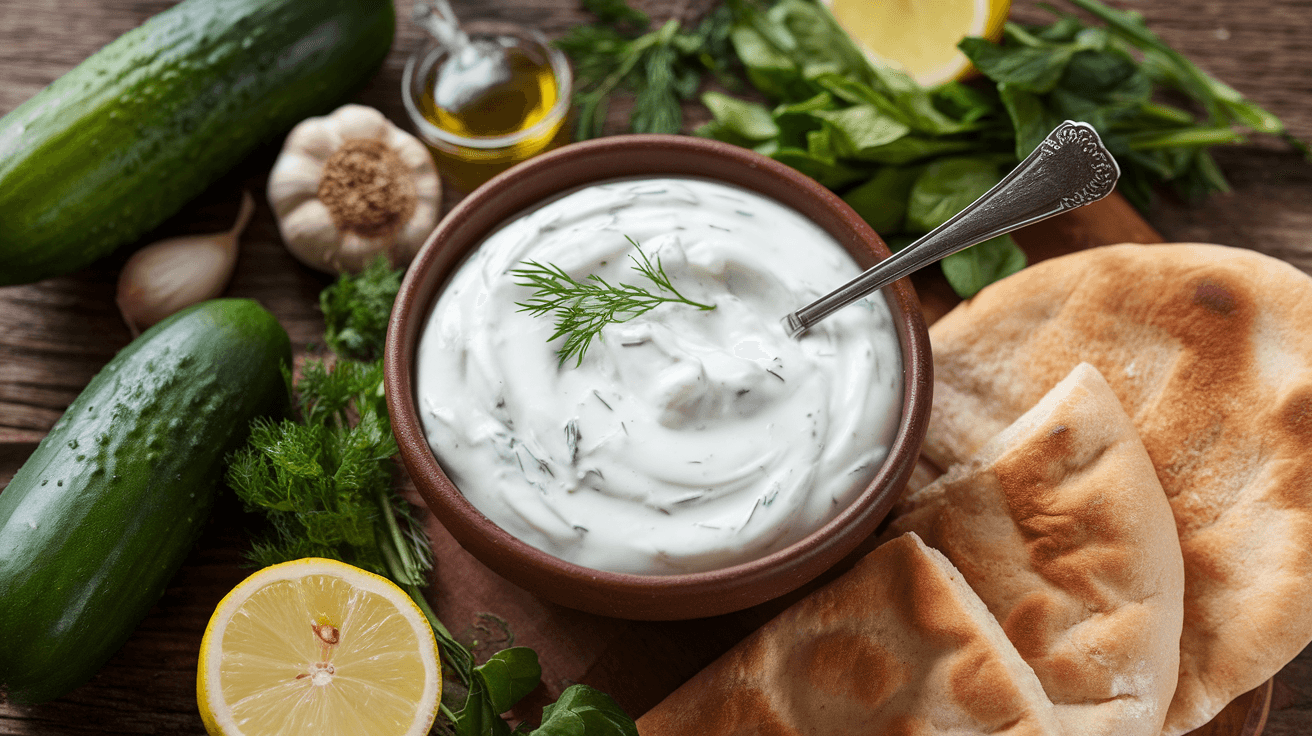Introduction

Tzatziki sauce is a creamy and refreshing dip that holds a beloved place in Mediterranean and Middle Eastern cuisines. Known for its rich flavor and light texture, tzatziki is made from simple, high-quality ingredients. These ingredients blend together harmoniously to create a delicious sauce. You can serve it with warm pita bread or as an accompaniment to grilled meats. This versatile staple adds a burst of freshness to any meal.
In this article, we’ll not only explore the origins of tzatziki sauce but also dive into its essential ingredients and preparation methods. Additionally, we will share valuable tips for creating the perfect version at home. By the end, you’ll have a complete understanding of this versatile and refreshing sauce, as well as how to make it part of your culinary repertoire.
What is Tzatziki Sauce?
Tzatziki sauce originates from Greek and Mediterranean cuisine and serves as a traditional and versatile condiment. This creamy yogurt-based dip combines fresh and zesty flavors, which pair perfectly with a wide variety of dishes. People enjoy tzatziki not only in Greece but also worldwide, where its light and refreshing qualities have made it a popular choice.
Origins and Cultural Significance
Tzatziki sauce traces its rich history back to ancient times, when people in the Middle East and Mediterranean regions began crafting similar recipes. Interestingly, many believe that tzatziki evolved from raita, a yogurt-based dip that remains popular in Indian cuisine. As trade routes connected distant regions, traders introduced raita to the Mediterranean, where it began to inspire local variations. Over the centuries, local ingredients such as olive oil, cucumbers, and dill gradually became essential components, ultimately shaping the tzatziki we know and enjoy today. Therefore, tzatziki stands as a testament to the blending of culinary traditions and the exchange of ideas across cultures.
In Greek culture, tzatziki represents more than just a sauce; it symbolizes hospitality and culinary tradition. Greeks often include it in mezze platters alongside other dips and appetizers or use it as a topping for dishes like gyros and souvlaki. Its global popularity grows steadily as more people discover its delicious and healthful properties.
What is Tzatziki Sauce?
Origins and Cultural Significance
Tzatziki sauce has its roots in Mediterranean and Middle Eastern cuisines, with its exact origins often attributed to Greek culinary traditions. The word “tzatziki” comes from the Turkish term “cacık,” which refers to a yogurt-based dish. Over time, tzatziki evolved into a popular accompaniment for various dishes across Greece, Turkey, and neighboring regions.
In Greek cuisine, tzatziki is a quintessential element of meze platters, often paired with olives, dolmades, and feta cheese. Its refreshing taste makes it a perfect complement to hearty dishes like souvlaki, gyros, and grilled meats, balancing out the rich and savory flavors with a cooling touch.
Beyond its culinary appeal, tzatziki holds cultural significance as a symbol of Greek hospitality and traditional cooking, celebrating the use of fresh, local ingredients.
Key Ingredients of Tzatziki Sauce
Yogurt: The Base
The foundation of tzatziki sauce is high-quality yogurt, traditionally made from sheep’s or goat’s milk in Greek recipes. Modern versions often use full-fat Greek yogurt for its thick and creamy texture. The yogurt provides a rich, tangy flavor that forms the backbone of the sauce while offering a smooth and luscious consistency.
Using strained yogurt is essential to avoid a watery sauce. Straining removes excess whey, ensuring the tzatziki maintains its thick and spreadable texture.
Cucumber: The Refreshing Element
Cucumber adds a fresh, crisp flavor to tzatziki. Typically, grated cucumber is used, and it’s essential to squeeze out as much water as possible to keep the sauce from becoming too thin. The cucumber provides a light and hydrating quality that complements the tanginess of the yogurt.
Cooks often prefer English cucumbers or Persian cucumbers for their mild taste and fewer seeds, but you can use any cucumber with proper preparation.
Garlic: The Flavor Enhancer
Garlic undeniably plays a crucial role in tzatziki sauce, as it adds bold and pungent flavors that elevate the dish. Typically, cooks finely mince or grate fresh garlic cloves before carefully mixing them into the yogurt base. Moreover, you can easily adjust the amount of garlic to suit your personal preference, ensuring the sauce meets your desired flavor intensity. However, it is important to note that authentic tzatziki traditionally features a strong garlic presence, which contributes significantly to its signature taste. Therefore, balancing the garlic flavor is key to crafting the perfect tzatziki.
Olive Oil: The Smooth Finish
A drizzle of high-quality extra virgin olive oil enhances the flavor and provides a silky finish to the sauce. Olive oil also helps to blend the ingredients together, creating a harmonious and rich texture.
Fresh Herbs: Dill and Mint
Herbs like dill and mint add depth and freshness to tzatziki. Dill, the most commonly used herb, offers a grassy, slightly tangy flavor. You can also include mint to introduce an additional layer of coolness and aroma.
Fresh herbs are preferred over dried ones for their vibrant taste, but dried herbs can be substituted in a pinch.
Lemon Juice: The Tangy Touch
Freshly squeezed lemon juice brightens the flavor profile of tzatziki, adding a zesty and tangy note. It complements the yogurt’s natural tartness and balances the richness of the other ingredients. Lime juice can be used as an alternative if lemons are unavailable.
How to Make Tzatziki Sauce at Home

Preparing the Ingredients
To make tzatziki sauce at home, start by gathering the essential ingredients: Greek yogurt, cucumber, garlic, olive oil, fresh herbs (dill and mint), lemon juice, and salt. Ensure all the ingredients are fresh and of high quality for the best flavor.
Begin by preparing the cucumber. Peel it if desired, then grate it using a box grater or food processor. Place the grated cucumber in a fine mesh strainer or cheesecloth, sprinkle it with a pinch of salt, and let it sit for about 10 minutes. Squeeze out the excess water thoroughly to prevent the sauce from becoming too watery.
Mince or grate the garlic cloves finely to ensure they blend seamlessly into the sauce. Chop the fresh herbs finely as well to distribute their flavors evenly.
Combining and Mixing
In a mixing bowl, combine the strained yogurt and prepared cucumber. Add the minced garlic, chopped herbs, a generous drizzle of olive oil, and freshly squeezed lemon juice. Mix all the ingredients together using a spoon or spatula until they are well incorporated.
At this stage, taste the mixture and adjust the flavors to your preference. Add more garlic for a stronger punch, more lemon juice for extra tang, or a touch of salt to enhance the overall flavor.
Adjusting Flavor
Tzatziki sauce is highly customizable, allowing you to tweak it to suit your palate. If you enjoy a creamier texture, you can add a small amount of sour cream or more yogurt. For a hint of sweetness, a drizzle of honey can balance the tanginess.
Once you’re satisfied with the flavor, cover the bowl with plastic wrap and let the sauce chill in the refrigerator for at least 30 minutes. This resting time allows the flavors to meld together, resulting in a more cohesive and delicious sauce.
Serve the tzatziki sauce chilled, garnished with a sprig of dill or a drizzle of olive oil for a professional touch.
Tips for the Perfect Tzatziki Sauce
Choosing the Best Yogurt
The yogurt you choose is the cornerstone of a delicious tzatziki sauce. Opt for full-fat Greek yogurt for its thick texture and rich flavor. If Greek yogurt isn’t available, you can use regular plain yogurt, but you’ll need to strain it through a cheesecloth or coffee filter for several hours to achieve the right consistency.
For a healthier alternative, low-fat or non-fat Greek yogurt works well, though it may have a slightly thinner texture. Always avoid flavored yogurts, as their sweetness can overpower the savory elements of tzatziki.
Techniques for Preparing Cucumber
Properly preparing the cucumber is key to preventing a watery sauce. After grating the cucumber, make sure to salt it lightly and let it sit for a few minutes. The salt draws out excess moisture, which you can then squeeze out using a clean kitchen towel or cheesecloth.
If you prefer a chunkier texture, dice the cucumber finely instead of grating it. For a smoother sauce, you can puree the cucumber with a food processor before mixing it into the yogurt base.
Balancing Flavors
A well-balanced tzatziki sauce should have a harmonious blend of tangy, creamy, garlicky, and herbal flavors. Start with small quantities of garlic and lemon juice, as their intensity can vary, and gradually add more to suit your taste.
For an extra layer of depth, experiment with a pinch of ground black pepper or a small amount of white vinegar. Always taste the sauce after mixing and adjust seasoning as needed to ensure all the flavors shine through.
Allowing the tzatziki to rest in the refrigerator not only thickens the sauce but also enhances the flavor as the ingredients meld together. If the sauce seems too thick after chilling, a splash of water or olive oil can help loosen it.
Uses and Serving Suggestions

Traditional Dishes Featuring Tzatziki
Tzatziki sauce is a staple in Mediterranean and Middle Eastern cuisines, often served alongside iconic dishes. In Greek cuisine, it is a must-have condiment for gyros, a pita sandwich filled with seasoned meat, vegetables, and tzatziki. It’s also commonly paired with souvlaki, a dish of skewered and grilled meat, where the sauce adds a cooling contrast to the smoky, savory flavors.
Meze platters often feature tzatziki alongside items like pita bread, dolmades (stuffed grape leaves), and olives, where it provides a creamy complement to the other dishes. Many people also pair tzatziki with roasted or grilled lamb, chicken, or seafood, making it a favorite accompaniment.
Modern Ways to Enjoy Tzatziki
Beyond traditional recipes, tzatziki has found its way into modern culinary applications. It works wonderfully as a healthy dip for raw vegetables like carrots, celery, and bell peppers. Spread it on sandwiches or wraps in place of mayonnaise for a lighter, tangier flavor.
For those seeking creative ideas, use tzatziki as a salad dressing, especially for cucumber or Mediterranean-style salads. Add it as a topping for baked potatoes, grain bowls, or roasted vegetables to introduce a creamy yet refreshing element to your dish.
When hosting, tzatziki can be served as a party dip alongside chips, crackers, or even toasted bread slices. Its versatility and vibrant flavor profile make it a crowd-pleasing addition to any table.
FAQs About Tzatziki Sauce
What makes tzatziki different from other dips?
Tzatziki stands out from other dips due to its creamy yogurt base, which provides a tangy and refreshing flavor. The combination of cucumber, garlic, olive oil, and fresh herbs gives it a unique taste that is lighter and more cooling compared to richer dips like hummus or guacamole.
Can tzatziki sauce be made vegan?
Yes, tzatziki sauce can be made vegan by replacing the yogurt with a plant-based alternative, such as coconut or almond yogurt. Ensure the yogurt is unsweetened to maintain the savory profile. The rest of the ingredients, such as cucumber, garlic, and herbs, remain the same.
How long does tzatziki last in the fridge?
Store tzatziki sauce in an airtight container in the refrigerator, and keep it for up to 3–4 days. For the best taste and texture, enjoy it fresh, as both can change over time. If the sauce separates slightly, stir it well before serving.
What can I use as a substitute for yogurt?
If yogurt isn’t available, sour cream can be used as a substitute to achieve a similar creamy consistency and tangy flavor. For a dairy-free option, consider using a thick cashew cream or silken tofu blended with lemon juice for the necessary tartness.
Is tzatziki sauce healthy?
Yes, tzatziki sauce is generally considered healthy due to its nutrient-rich ingredients. Greek yogurt provides protein and probiotics, while cucumber and herbs add vitamins and antioxidants. It is low in calories and fat compared to many other dips, making it a great choice for those looking to eat healthily.
Conclusion
Tzatziki sauce is a versatile and beloved condiment with roots in Mediterranean cuisine. Made from simple, wholesome ingredients like Greek yogurt, cucumber, garlic, olive oil, and fresh herbs, it offers a refreshing and tangy flavor that complements a wide variety of dishes. Whether served traditionally with gyros and souvlaki or enjoyed as a modern dip or spread, tzatziki brings a burst of freshness to every meal.
With its ease of preparation and customizable nature, tzatziki sauce is an accessible recipe for cooks of all skill levels. By following the tips shared in this guide, you can create a homemade version that rivals even the most authentic restaurant offerings.
Now that you know what tzatziki sauce is made of and how to make it, why not give it a try in your own kitchen? Whether you’re hosting a dinner party or simply looking for a healthy and flavorful addition to your meals, tzatziki is sure to impress. Enjoy!

